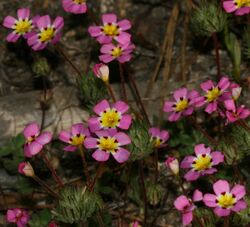Biology:Leptosiphon montanus
| Leptosiphon montanus | |
|---|---|

| |
| Scientific classification | |
| Kingdom: | Plantae |
| Clade: | Tracheophytes |
| Clade: | Angiosperms |
| Clade: | Eudicots |
| Clade: | Asterids |
| Order: | Ericales |
| Family: | Polemoniaceae |
| Genus: | Leptosiphon |
| Species: | L. montanus
|
| Binomial name | |
| Leptosiphon montanus (Greene) J.M.Porter & L.A.Johnson
| |
| Synonyms | |
|
Linanthus montanus | |
Leptosiphon montanus (syn. Linanthus montanus) is a species of flowering plant in the phlox family known by the common name mustang clover.[1][2]
Distribution
It is endemic to California . It grows in dry openings of oak woodland habitats in the western Sierra Nevada foothills, from 300–1,700 metres (980–5,580 ft) in elevation.[1]
Description
Leptosiphon montanus is an annual herb producing a thin, hairy stem up to 60 centimeters tall. The leaves are divided into needle-like linear lobes each 2 or 3 centimeters in length.[1]
The inflorescence is a head of small but showy flowers. Each flower has a long, hairy, dark red tube up to 3 centimeters long spreading into a flat corolla. The corolla lobes are white or light to deep pink marked with reddish spots at the yellow and white throat. Its bloom period is from April to July.[1]
See also
References
External links
- Calflora Database: Leptosiphon montanus (Mustang clover)
- Jepson Manual eFlora (TJM2) treatment of Leptosiphon montanus[yes|permanent dead link|dead link}}]
Wikidata ☰ Q6528353 entry
 |

